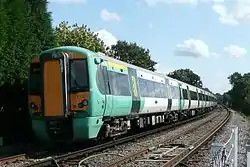British Rail Class 377
The British Rail Class 377 Electrostar is a British dual-voltage electric multiple unit train (EMU) built by Bombardier Transportation at its Derby Litchurch Lane Works, from 2001 to 2014. The Electrostar family is the most numerous type of EMU built in the post-privatisation period of Britain's railways.
| British Rail Class 377 Electrostar | |
|---|---|
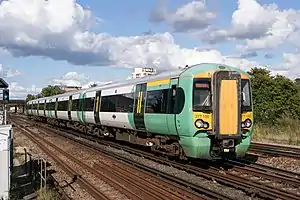 Southern 377150 approaching Norwood Junction in 2015 | |
 The interior of a Southern Class 377/6 | |
| In service | May 2003 – present |
| Manufacturer | Bombardier Transportation |
| Built at | Derby Litchurch Lane Works |
| Family name | Electrostar |
| Replaced | |
| Number built | 211 units (excluding 28 375/3 conversions) |
| Number in service | 239 units |
| Formation |
|
| Operator(s) | |
| Specifications | |
| Car length | 20.4 m (66 ft 11 1⁄8 in) |
| Width | 2.80 m (9 ft 2 1⁄4 in) |
| Height | 3.78 m (12 ft 4 7⁄8 in) |
| Maximum speed | 100 mph (161 km/h) |
| Weight |
|
| Power output |
|
| Electric system(s) |
|
| Current collection method |
|
| Multiple working | Within class |
| Track gauge | 1,435 mm (4 ft 8 1⁄2 in) standard gauge |
The class forms the major part of the Govia Thameslink Railway (GTR) fleet for Southern services and now also supplement some Southeastern services. They are primarily seen on services in the south of England.
Description
The units work suburban services in South London, and main line commuter services to Sussex, Surrey, Kent and the South Coast, on which they replaced 4Cig and 4Vep slam-door stock, which was more than 40 years old and did not meet modern health and safety requirements. Built in the early 2000s, the units had a troubled introduction; being fully air-conditioned, their higher power consumption compared to the slam-door Mark 1 stock that they replaced led to major upgrades being required to the 750 V DC third-rail power supply used in the former Southern region.[1] The collapse of Railtrack following the Hatfield accident further delayed this upgrade work, and the new stock did not enter squadron service until 2003.
Class 377s are fitted with external CCTV. There is an open area for wheelchairs or prams, and both intermediate coaches have toilets. Bodyside power doors are electrically operated, a move away from the air powered systems of previous generation EMUs. Dual-voltage units are fitted with a Brecknell Willis high-speed pantograph, incorporating a pair of aerofoils on the pan knuckle to steady the pan head against the OLE contact wire.[2] The configuration of a 5-car Class 377 unit is:
- DMOC(A) – 2 motors on inner bogie, sander, auxiliary converter module
- MOSL – 2 motors on inner bogie, standard toilet (not found on 377/3s)
- PTSOL – pantograph, transformer, compressor, universal access toilet
- MOS – 2 motors on inner bogie, standard class interior (only found on Class 377/6 and 377/7 units)
- DMOS(B) – 2 motors on inner bogie, sander, auxiliary converter module
In 4-car units, the driving cars are composite, with the first-class saloon between the driving cab and the first set of passenger doors. 4-car units also do not contain the MOS coach.
Couplers
The Class 377 uses Dellner[3] couplers instead of the Tightlock type originally used on Southern's Class 375s. Southern's 375s were all reclassified to Class 377/3s upon conversion – these reclassified units can still be identified by their 3-car formation. Note that Southeastern's 375s (sub-classes 375/3, 375/6, and 375/7) were also later converted from Tightlock to Dellner couplers but were not reclassified; its sub-class 375/8 and 375/9 units were fitted with Dellner couplers, as built.[4]
Traction current supply
All units can receive power via third-rail pick-up which provides 750 V DC. There are eight pick-up shoes per unit (twice the number of previous generation 4-car Electric multiple units), and this enables them to ride smoothly over most third-rail gaps. The units in the 377/2, 377/5 and 377/7 sub-classes are dual-voltage, and are fitted with a pantograph to pick up 25 kV AC from overhead lines. On these units (and on single-voltage sub-class 377/6), the shoe mechanism is air-operated so that when powered down, or working on AC overhead lines, they are raised out of the way. This is used on trains from Milton Keynes to East Croydon which use part of the West Coast Main Line between Milton Keynes and Willesden Junction, and then the West London Line towards Clapham Junction. These trains change to third-rail DC supply on a dual-voltage section of the West London line north of Shepherd's Bush.[5] Since March 2009, dual-voltage Class 377 units have also been operating some Thameslink Bedford to Brighton, Rochester and Ashford services. (See below).
Among the remaining units, the trailer coach in each unit has a recess in its roof where a pantograph could be fitted, to allow for future conversion to overhead AC power.
Additional units and the Thameslink Programme
In April 2007, as part of the Route Utilisation Strategy for the Brighton Main Line, it was announced that Southern would procure an additional 48 Class 377 carriages to replace an identical number of Class 319 carriages (12 4-car units) due to be transferred to First Capital Connect.[6] Eleven further dual-voltage units were then added to the order, making a total of 23. They were ordered from Bombardier in March 2008 and were delivered in First's corporate colour scheme but with Southern spec interior (green seats).[7] The units were commissioned at Southern's Selhurst depot in Croydon before being transferred to First Capital Connect's Bedford Cauldwell depot. The first of these, unit 377501, was delivered to Cauldwell depot on 27 February 2009 after making its first appearance through the Thameslink Central London core. The 377/5s operate mainly on Bedford to Brighton services but in the peaks form part of FCC's and Southeastern's new joint service to places such as Rochester and Ashford.
Delays in the construction of the Class 377/5s for First Capital Connect saw the temporary transfer of eight of Southern's Class 377/2s to FCC to enable them to implement the planned timetable changes on 22 March 2009; the loss of these units until September 2009 was covered by the temporary cascade of a number of Class 350/1s to Southern from London Midland, which operated services between East Croydon and Milton Keynes.[8]
In September 2011, it was announced that Southern had begun the procurement of 130 vehicles, due to delays in the procurement of new Thameslink rolling stock that would prevent transfer of the 377/5s in time for the December 2013 timetable change.[9] The contract was awarded to Bombardier in December 2011.[10][11] The additional eight five-car units (from an option in the contract for 40 additional vehicles) are dual-voltage and known as Class 377/7.[12]
In December 2011, three Class 377/2 units were transferred from Southern to First Capital Connect (now Thameslink) to allow more 12-car services to be run.
During mid-2013, the first of the new Class 377/6s arrived from Derby for type testing, and since October 2013, these units have been used in passenger service, initially in peak-hour services on the Sutton and Mole Valley lines, Epsom Downs Branch, Tattenham Corner Line and the Caterham Line.
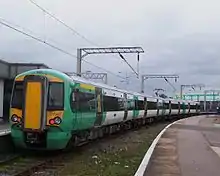

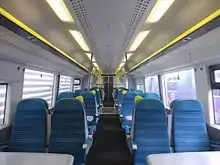
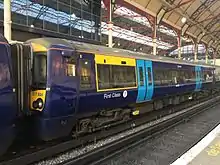
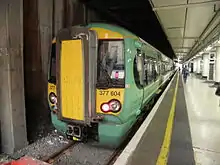
Southeastern received 25 Class 377 units (the 23 Class 377/5s and 2 Class 377/1s) in recent years, as specified in Department for Transport documents, published in September 2013, relating to the new combined Thameslink, Southern and Great Northern Franchise.[13]
Current operations
Southern
- Mainline and Redhill Routes: London to Brighton, Horsham, Reigate, Tonbridge, Eastbourne, Ore, Portsmouth, Southampton, Littlehampton and Bognor Regis
- East Coastway: Brighton to Eastbourne, Hastings, Ore and selected workings along the Seaford branch line
- West Coastway: Brighton to Portsmouth, Littlehampton, Bognor Regis and Southampton (selected workings)
- West London Route: East Croydon to Milton Keynes Central
- Oxted Line: London to East Grinstead
- Outer Suburban services: Central London to Tattenham Corner, Epsom, Horsham, Dorking, Guildford
- Inner Suburban services: Central London to Caterham, Sutton, Epsom Downs, West Croydon, Beckenham Junction via Crystal Palace (selected workings)
Southeastern
In December 2016 Southeastern received 8 units (377501-377508), transferred from Thameslink. In September 2017 these were joined by an additional 17 units (377509-523 & 377163/164).[14] These units will be serviced and maintained at Southern's Selhurst Depot.
Southeastern operates Class 377s on the following routes:
- Maidstone East Line: London Victoria/Blackfriars to Ashford International/Canterbury West via Maidstone East
- Chatham Main Line: London Victoria/Cannon Street to Ramsgate (selected workings)
- South Eastern Main Line: London Charing Cross to Ashford International/Folkestone Central (selected peak hour workings)
Aborted Proposals
Great Northern
In 2016, 19 of the 23 Class 377/5 units were planned to be transferred to Great Northern, for use on non-stop London-Cambridge services. However, the 29 former Thameslink Class 387/1s were transferred, instead.[15] The Class 377/5s were later transferred to Southeastern, as part of their requirement for additional capacity.
Fleet details
| Class | Operator | No. Built | Year Built | Cars | Unit nos. | Notes |
|---|---|---|---|---|---|---|
| 377/1 | Southern | 62 | 2002–03 | 4 | 377101-162 | All 3rd rail routes. 377163/4 transferred to Southeastern in October 2017.[16] |
| Southeastern | 2 | 377163-164 | ||||
| 377/2 | Southern | 15 | 2003–04 | 377201-215 | Dual-voltage units. These are used on the East Croydon – Milton Keynes Central route as well as Metro routes in South London and occasionally main line workings to the South Coast. | |
| 377/3 | 28 | 2001–02 | 3 | 377301-328 | 3-car units converted from Class 375 Nos. 375311-338 by having their Tightlock couplers replaced by Dellners. Originally used on Coastway services but have now moved to London suburban services, being partly replaced by Class 313s. | |
| 1 | 2004–05 | 377342 | Converted from a Class 377/4 after fire damage. | |||
| 377/4 | 74 | 4 | 377401-441 377443-475 |
All 3rd rail routes. One unit converted to Class 377/3 after fire damage. | ||
| 377/5 | Southeastern | 23 | 2008–09 | 377501-523 | Dual-voltage units. All units were transferred from Thameslink to Southeastern during 2016–17 to bolster their existing Class 375 fleet. | |
| 377/6 | Southern | 26 | 2012–13 | 5 | 377601-626[12] | Used on London suburban routes, extending as far as Dorking and Horsham, as well as Tattenham Corner/Caterham services, splitting and attaching at Purley. Run to Brighton at weekends. Also used on the East/West Coastway during events such as the Eastbourne Airshow. |
| 377/7 | 8 | 2014 | 377701-708[12] | Additional 8 dual-voltage five-car units intended to be used on the East Croydon – Milton Keynes Central services, and metro duties shared with the 377/6s.[17] The 40 vehicles were built in 5-car formation with dual voltage configuration, costing circa £60 million in total, and they were delivered during 2014 for service entry in December of that year. |


Accidents and incidents
On 28 November 2016, a fire broke out in the MOSL car of a Southern Class 377 (unit 377442) at Eastbourne station, causing damage to the ceiling and interior. The cause was later identified to be faulty wiring within a hand dryer located in the toilet.[18]
On 17 February 2018, a 377 (unit 377454) hit a car on a level crossing at Barns Green near Horsham. The two occupants of the car died at the scene.[19]
On 8 May 2019, 377142 collided with the buffer stop at London Victoria Station.[20]
On 23 August 2020, 377317 was derailed at the exit of the Jubilee Sidings, Tonbridge.[21]
References
- Ford, Roger (May 2003). "SR power upgrade agreements signed". Modern Railways. London. Archived from the original on 4 June 2011.
- First Capital Connect: Class 377 Drivers' Guide p.91 "The pantograph" 2009.
- "Dellner Couplers AB — Automatic and Semi-Permanent Couplers". Retrieved 10 October 2014.
- "Southern Electric Fleet Review Summer 2004". Southern Electric Group. 21 April 2006. Archived from the original on 23 February 2013.
- Jacobs, G. (ed) (2008). Railway Track Diagrams 5: Southern and TfL (3rd edition). Bradford-on-Avon: Quail. p. 1R.
- "More trains arriving on busy rail routes". Department for Transport. 4 April 2007. Archived from the original on 5 July 2007.
- "Flickr".
- "All Aboard for the latest game of musical trains on the National Network" (PDF). Railway Herald (169). Scunthorpe. p. 4.
- "Could Southern be the lifeline for Bombardier?" (PDF). Railway Herald (284). Scunthorpe. p. 3.
- "Boost for Derby as Bombardier wins Southern order". Railnews. 28 December 2011. Retrieved 9 January 2012.
- "DfT acts to ease Thameslink trains logjam". Railnews. 16 November 2012. Retrieved 16 November 2012.
- Today's Railways. March 2013. Issue 135. Page 31. The article states that the additional 8 units were initially 377624-634 but have been reclassified due to the dual-voltage option being taken up.
- "Thameslink, Southern and Great Northern Franchise: Invitation to Tender" (PDF). London: Department for Transport. September 2013. p. 75. Retrieved 9 October 2013.
- "Coming to a station near you: 68 extra train carriages on busiest Southeastern routes". Southeastern. Retrieved 18 September 2017.
- "Trio of GTR Class 387/1s readied for move to Great Northern duties". PressReader. Retrieved 4 August 2016.
- "Coming to a station near you: 68 extra train carriages on busiest Southeastern routes". Southeastern. Retrieved 18 September 2017.
- "Procurement of New Rolling Stock" (Press release). Southern. 15 November 2012. Archived from the original on 29 March 2013.
- "Hand dryer caused Eastbourne train fire". Eastbourne Herald. 2 December 2016. Retrieved 20 September 2018.
- "Barns Green: Boy and granddad die as train hits car". BBC News. 17 February 2018. Retrieved 20 September 2018.
- Clifton, Katy. "Victoria station crash: Southern Rail train 'hits buffers causing loud bang and smoke' in front of shocked commuters". Evening Standard. Retrieved 8 May 2019.
- Network Rail [@NetworkRailSE] (24 August 2020). "Due to Sunday's low-speed derailment of an empty train in the depot near Tonbridge Station our engineers are continuing to work to re-rail the train and check the signalling and track systems in the area" (Tweet). Retrieved 24 August 2020 – via Twitter.
External links
 Media related to British Rail Class 377 at Wikimedia Commons
Media related to British Rail Class 377 at Wikimedia Commons
